Abstract
Two dogs were diagnosed as malignant hyperthermia susceptible based on increased susceptibility (P less than 0.001) of biopsied muscle to caffeine-induced contracture. Erythrocytes from malignant hyperthermia and normal dogs were then examined for an antioxidant system deficiency. Values for serum muscle enzymes, reticulocytes and corpuscular hemoglobin were mildly elevated. Osmotic fragility was increased: hemolysis occurred at a NaCl concentration 10 mM higher than for normal dogs (P less than 0.001). A 35% glucose-6-phosphate dehydrogenase deficiency (P less than 0.001) with a 40% compensatory increase (P less than 0.01) in 6-phosphogluconate dehydrogenase activity was found. The membrane Ca2+-activated ATPase activity was abnormal: 100% increased with a 40% decreased Arrhenius activation energy (P less than 0.005) and increased thermostability. A 40% increased intracellular accumulation of total Ca2+ occurred in response to in vitro energy depletion in erythrocytes from one malignant hyperthermia dog (P less than 0.01). The multifactorial pattern of inheritance and the broad spectrum of malignant hyperthermia susceptibility are proposed to result from an antioxidant system deficit unmasking or aggravating an intrinsic muscle membrane anomaly. An individual from a family with a history of malignant hyperthermia or unexplained anesthetic death should be considered malignant hyperthermia susceptible if erythrocyte osmotic fragility is abnormal and there is a mild, unexplained elevation in serum creatine kinase.
Full text
PDF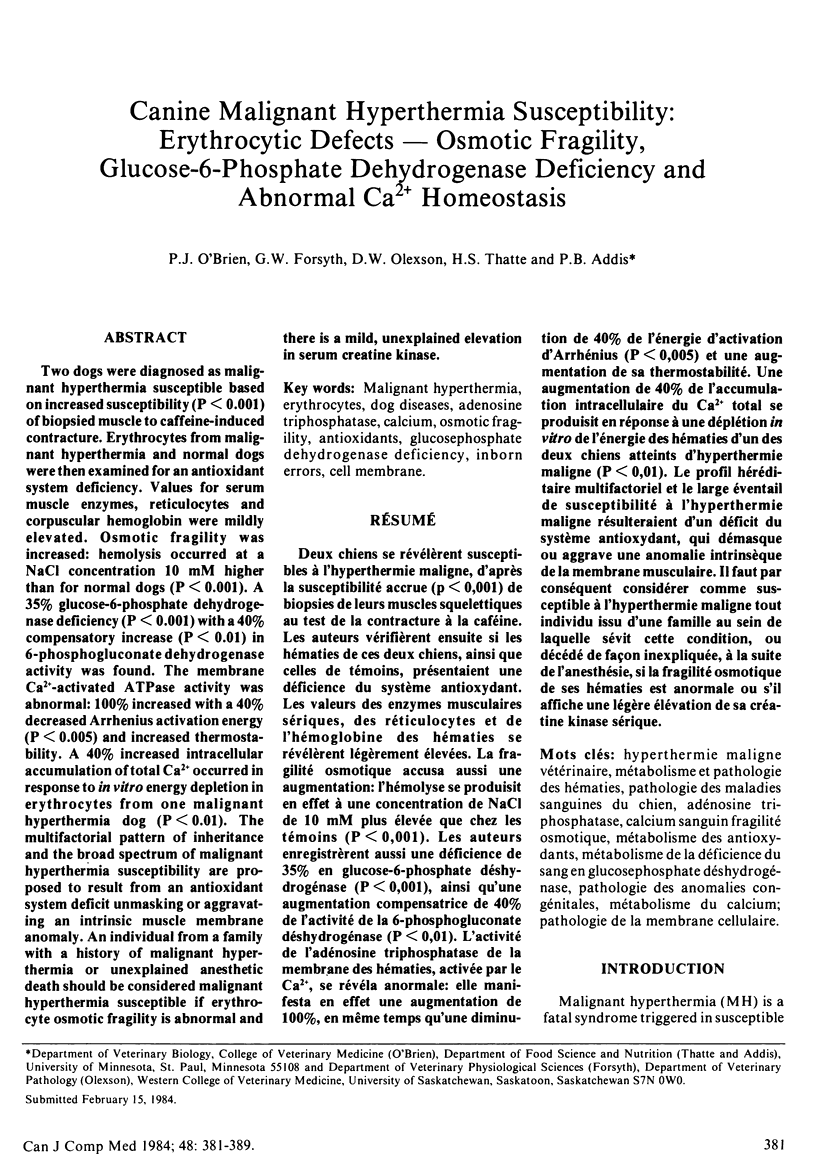
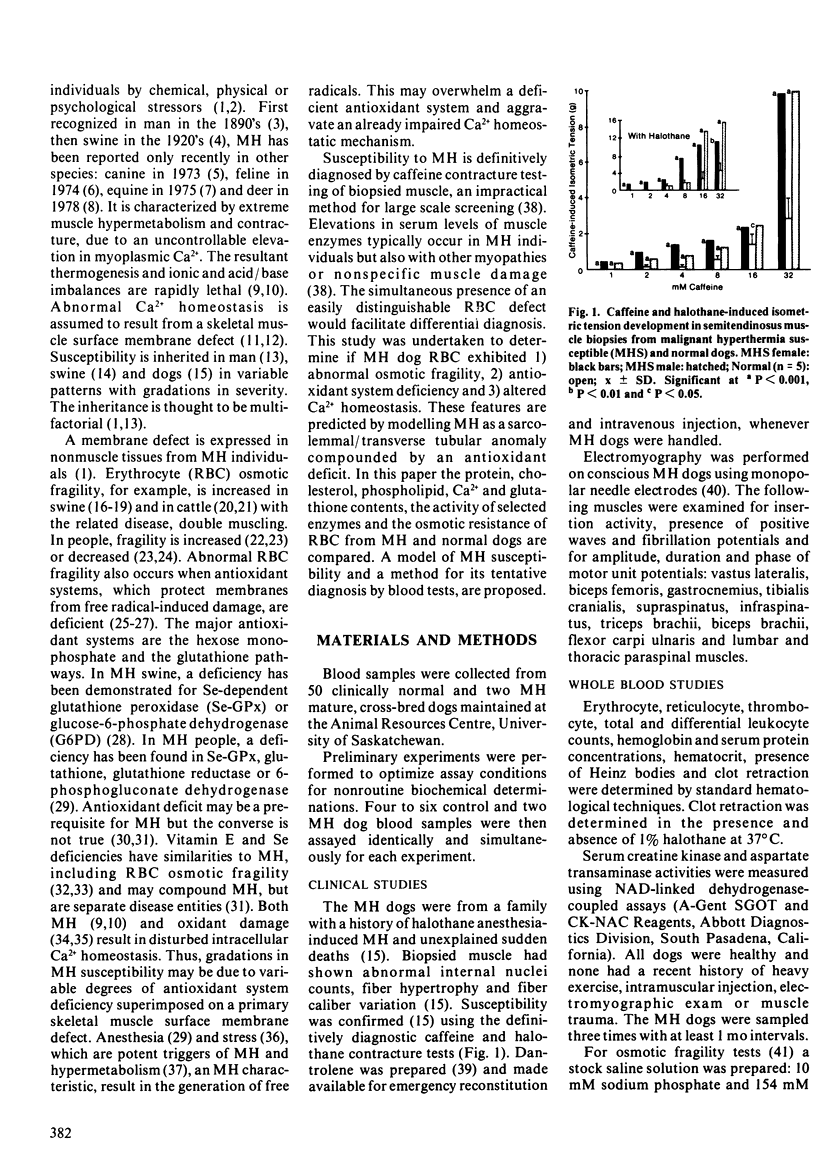
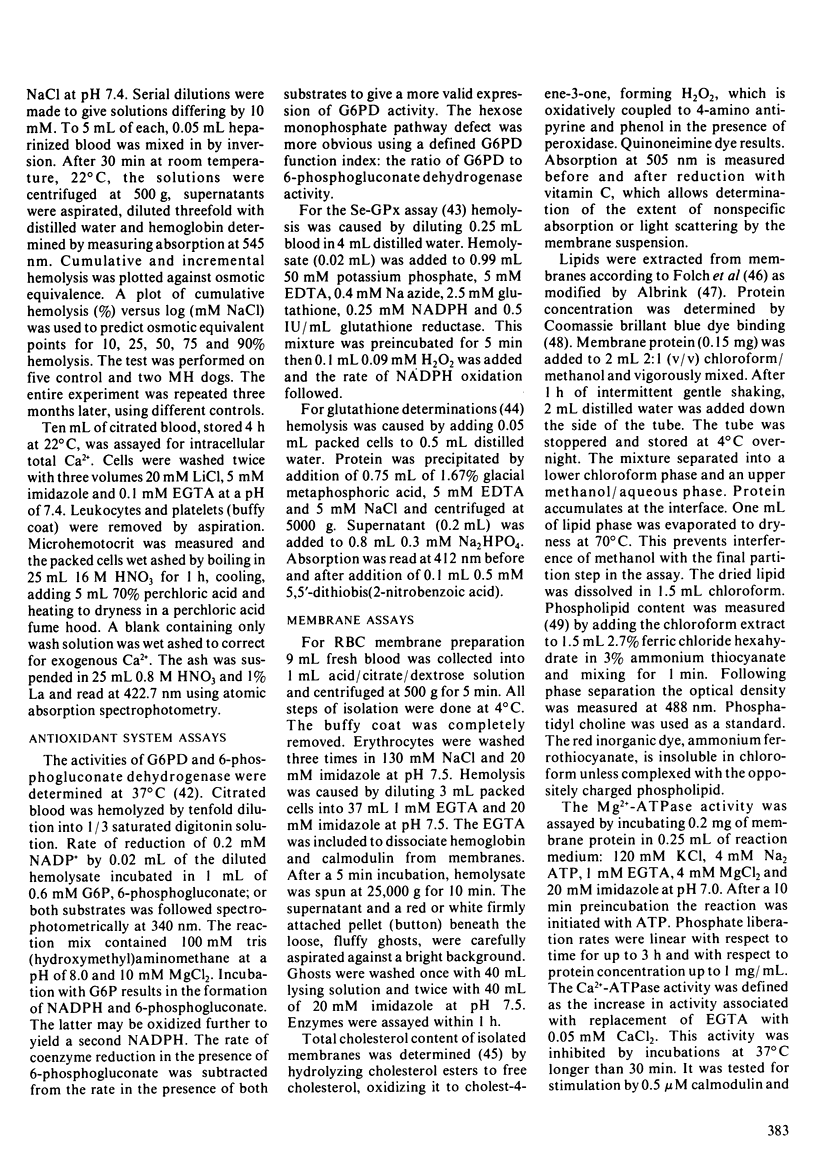
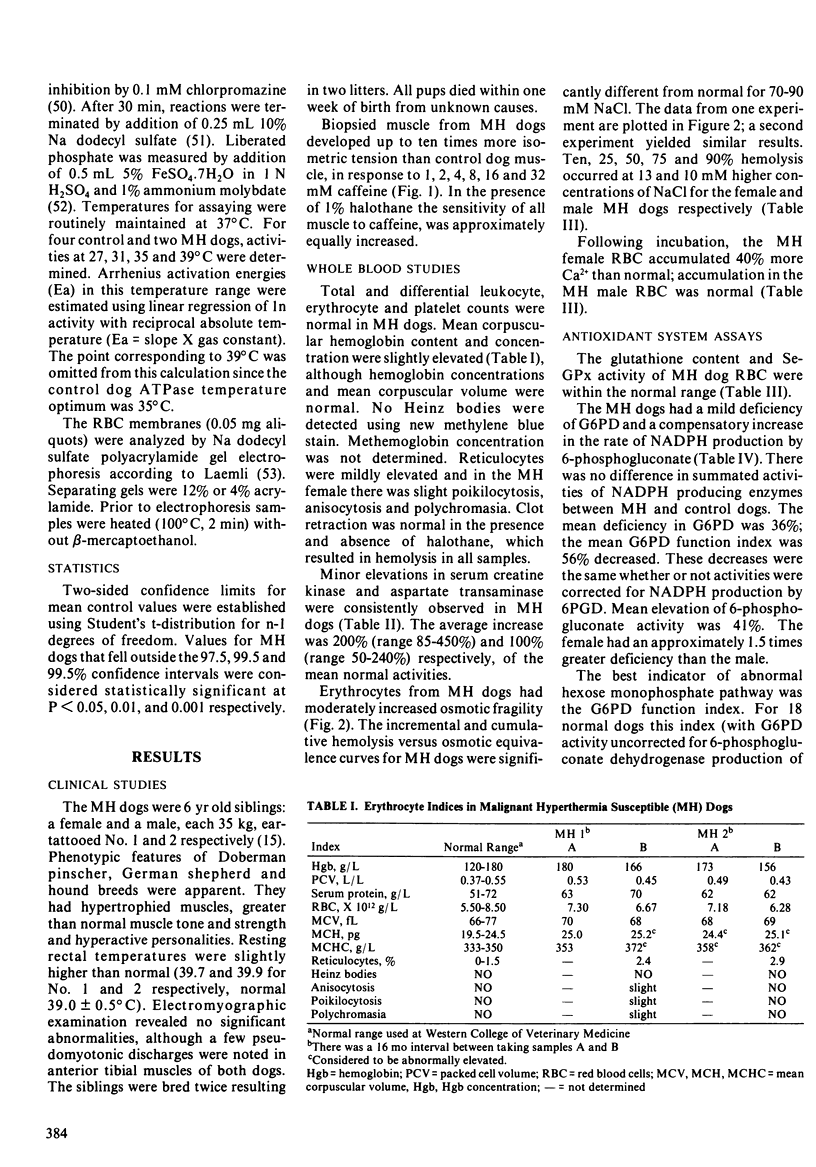
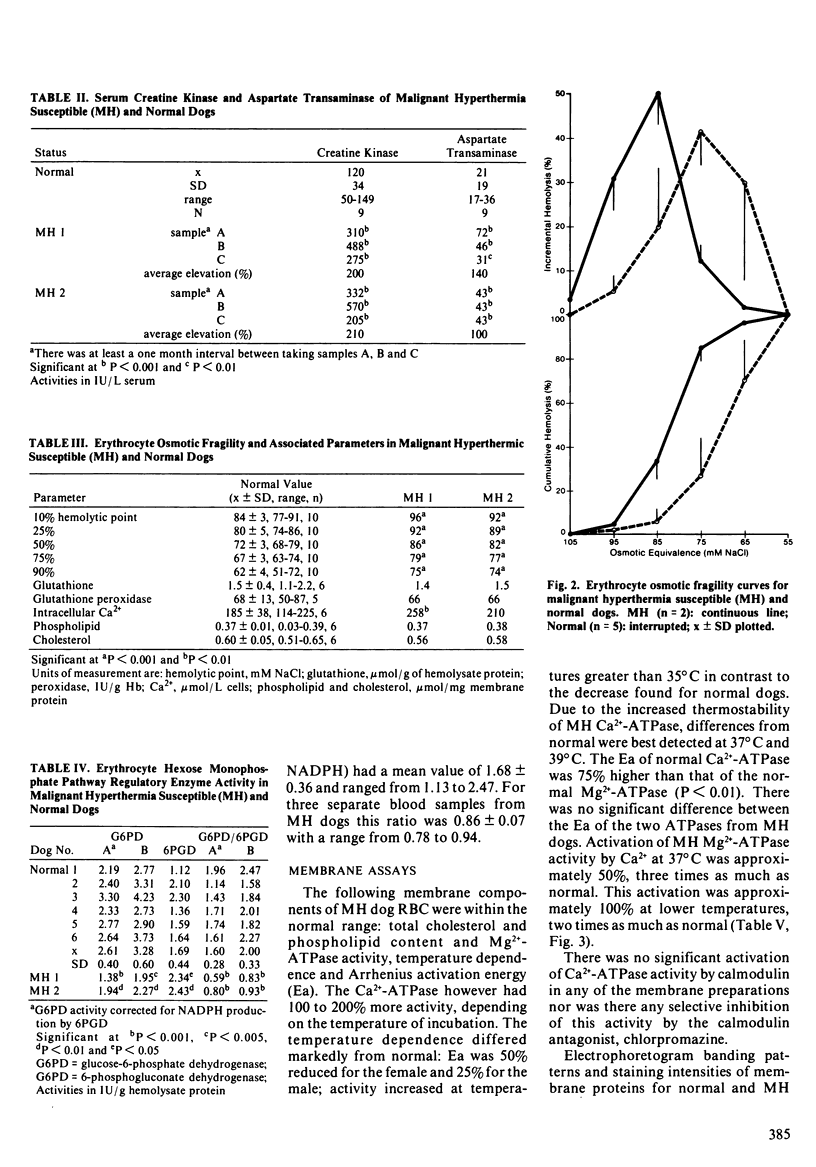
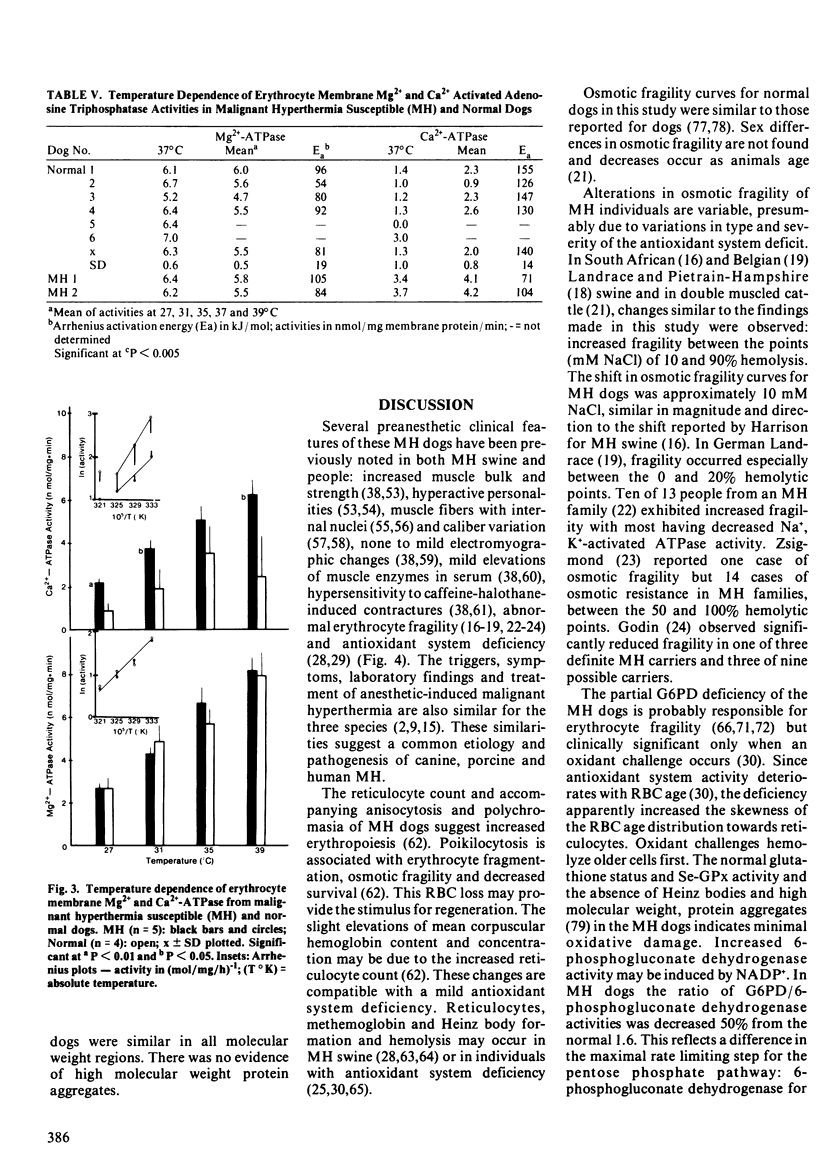
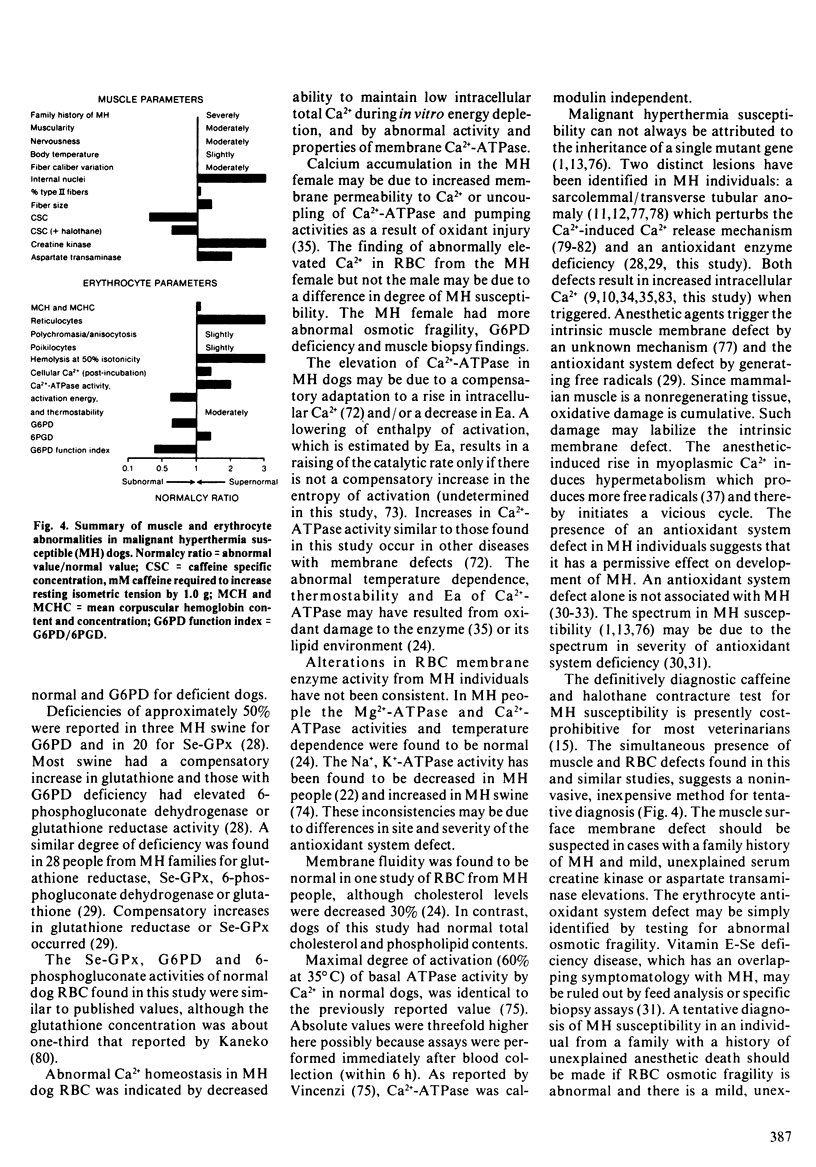
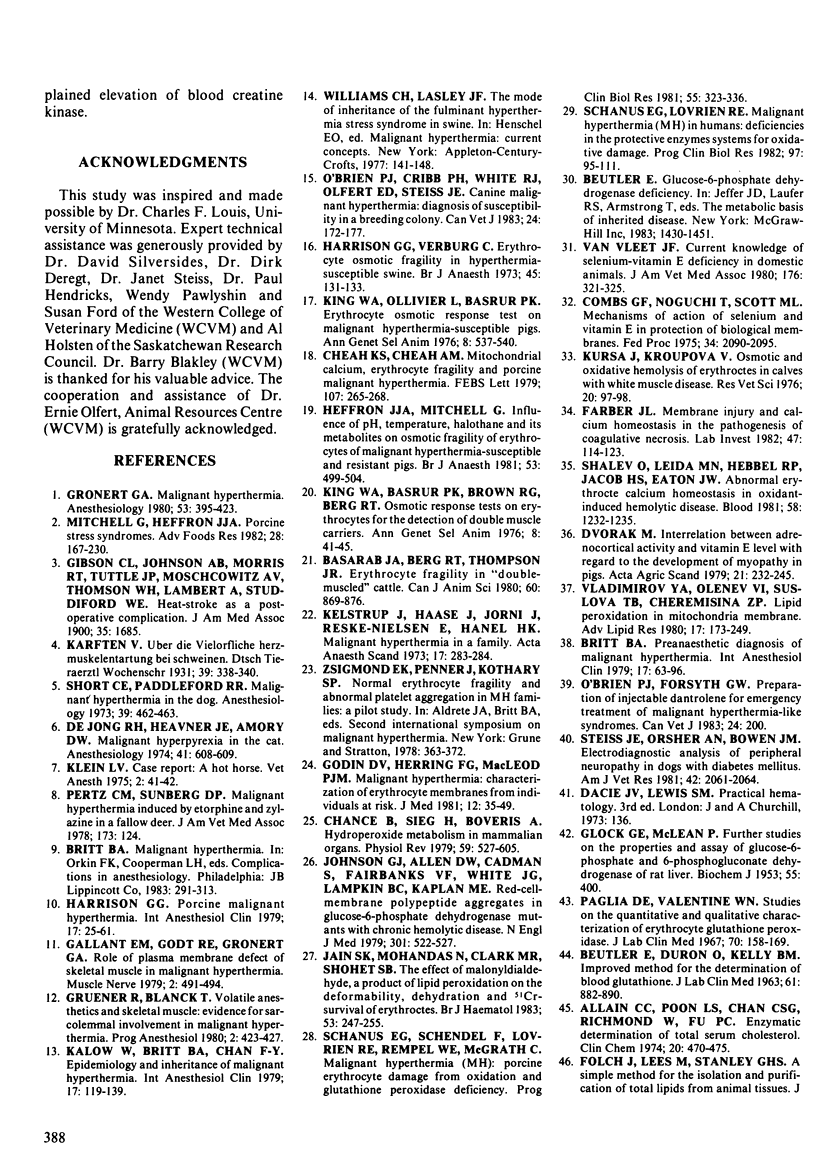
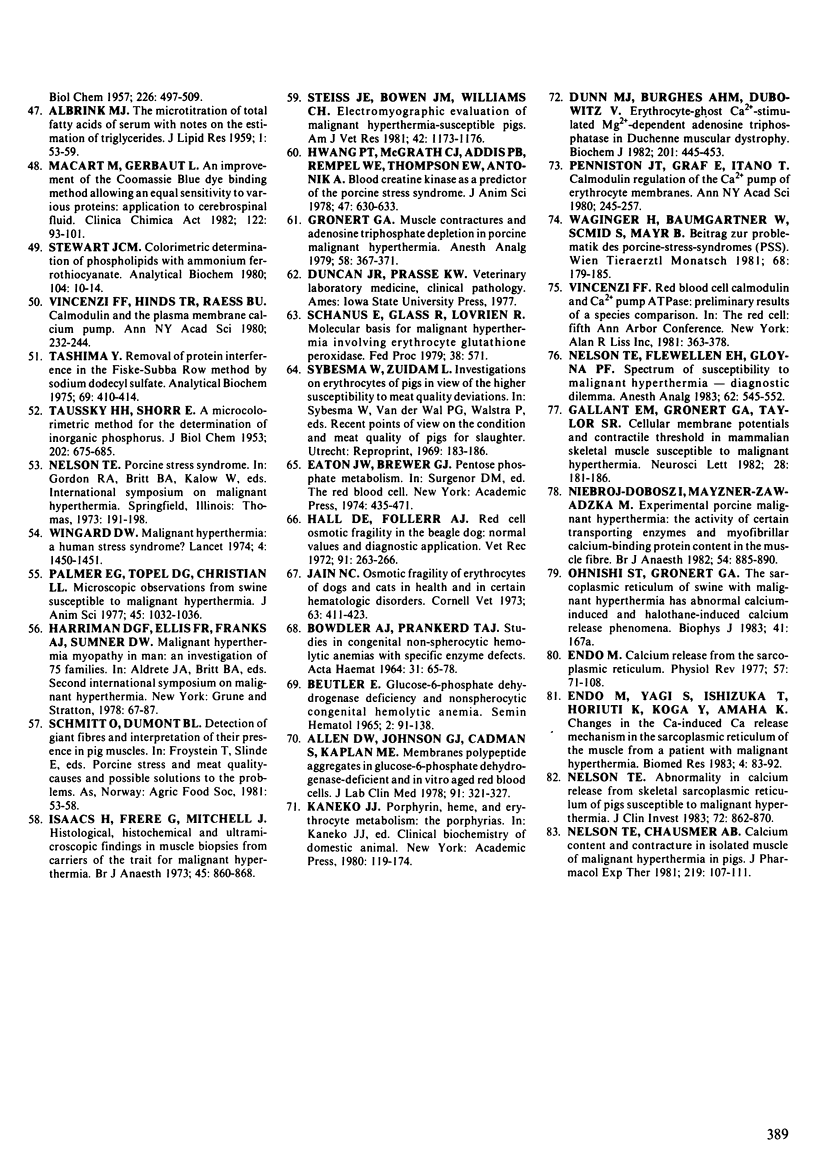
Selected References
These references are in PubMed. This may not be the complete list of references from this article.
- Allain C. C., Poon L. S., Chan C. S., Richmond W., Fu P. C. Enzymatic determination of total serum cholesterol. Clin Chem. 1974 Apr;20(4):470–475. [PubMed] [Google Scholar]
- Allen D. W., Johnson G. J., Cadman S., Kaplan M. E. Membrane polypeptide aggregates in glucose 6-phosphate dehydrogenase-deficient and in vitro aged red blood cells. J Lab Clin Med. 1978 Feb;91(2):321–327. [PubMed] [Google Scholar]
- BEUTLER E., DURON O., KELLY B. M. Improved method for the determination of blood glutathione. J Lab Clin Med. 1963 May;61:882–888. [PubMed] [Google Scholar]
- BEUTLER E. GLUCOSE-6-PHOSPHATE DEHYDROGENASE DEFICIENCY AND NONSPHEROCYTIC CONGENITAL HEMOLYTIC ANEMIA. Semin Hematol. 1965 Apr;2:91–138. [PubMed] [Google Scholar]
- BOWDLER A. J., PRANKERD T. A. STUDIES IN CONGENITAL NON-SPHEROCYTIC HAEMOLYTIC ANAEMIAS WITH SPECIFIC ENZYME DEFECTS. Acta Haematol. 1964 Feb;31:65–78. doi: 10.1159/000209615. [DOI] [PubMed] [Google Scholar]
- Britt B. A. Preanesthetic diagnosis of malignant hyperthermia. Int Anesthesiol Clin. 1979 Winter;17(4):63–96. doi: 10.1097/00004311-197917040-00006. [DOI] [PubMed] [Google Scholar]
- Chance B., Sies H., Boveris A. Hydroperoxide metabolism in mammalian organs. Physiol Rev. 1979 Jul;59(3):527–605. doi: 10.1152/physrev.1979.59.3.527. [DOI] [PubMed] [Google Scholar]
- Cheah K. S., Cheah A. M. Mitochondrial calcium, erythrocyte fragility and porcine malignant hyperthermia. FEBS Lett. 1979 Nov 15;107(2):265–268. doi: 10.1016/0014-5793(79)80386-5. [DOI] [PubMed] [Google Scholar]
- Combs G. F., Jr, Noguchi T., Scott M. L. Mechanisms of action of selenium and vitamin E in protection of biological membranes. Fed Proc. 1975 Oct;34(11):2090–2095. [PubMed] [Google Scholar]
- Dunn M. J., Burghes A. H., Dubowitz V. Erythrocyte-ghost Ca2+-stimulated Mg2+-dependent adenosine triphosphatase in Duchenne muscular dystrophy. Biochem J. 1982 Mar 1;201(3):445–453. doi: 10.1042/bj2010445. [DOI] [PMC free article] [PubMed] [Google Scholar]
- Endo M. Calcium release from the sarcoplasmic reticulum. Physiol Rev. 1977 Jan;57(1):71–108. doi: 10.1152/physrev.1977.57.1.71. [DOI] [PubMed] [Google Scholar]
- Farber J. L. Biology of disease: membrane injury and calcium homeostasis in the pathogenesis of coagulative necrosis. Lab Invest. 1982 Aug;47(2):114–123. [PubMed] [Google Scholar]
- GLOCK G. E., McLEAN P. Further studies on the properties and assay of glucose 6-phosphate dehydrogenase and 6-phosphogluconate dehydrogenase of rat liver. Biochem J. 1953 Oct;55(3):400–408. doi: 10.1042/bj0550400. [DOI] [PMC free article] [PubMed] [Google Scholar]
- Gallant E. M., Godt R. E., Gronert G. A. Role of plasma membrane defect of skeletal muscle in malignant hyperthermia. Muscle Nerve. 1979 Nov-Dec;2(6):491–494. doi: 10.1002/mus.880020610. [DOI] [PubMed] [Google Scholar]
- Gallant E. M., Gronert G. A., Taylor S. R. Cellular membrane potentials and contractile threshold in mammalian skeletal muscle susceptible to malignant hyperthermia. Neurosci Lett. 1982 Feb 12;28(2):181–186. doi: 10.1016/0304-3940(82)90149-5. [DOI] [PubMed] [Google Scholar]
- Gronert G. A. Malignant hyperthermia. Anesthesiology. 1980 Nov;53(5):395–423. doi: 10.1097/00000542-198011000-00007. [DOI] [PubMed] [Google Scholar]
- Gronert G. A. Muscle contractures and adenosine triphosphate depletion in porcine malignant hyperthermia. Anesth Analg. 1979 Sep-Oct;58(5):367–371. doi: 10.1213/00000539-197909000-00004. [DOI] [PubMed] [Google Scholar]
- Hall D. E., Follett A. J. Red cell osmotic fragility in the Beagle dog: normal values and diagnostic application. Vet Rec. 1972 Sep 9;91(11):263–267. doi: 10.1136/vr.91.11.263. [DOI] [PubMed] [Google Scholar]
- Harrison G. G. Porcine malignant hyperthermia. Int Anesthesiol Clin. 1979 Winter;17(4):25–61. doi: 10.1097/00004311-197917040-00005. [DOI] [PubMed] [Google Scholar]
- Harrison G. G., Verburg C. Erythrocyte osmotic fragility in hyperthermia-susceptible swine. Br J Anaesth. 1973 Feb;45(2):131–133. doi: 10.1093/bja/45.2.131. [DOI] [PubMed] [Google Scholar]
- Heffron J. J., Mitchell G. Influence of pH, temperature, halothane and its metabolites on osmotic fragility of erythrocytes of malignant hyperthermia-susceptible and resistant pigs. Br J Anaesth. 1981 May;53(5):499–504. doi: 10.1093/bja/53.5.499. [DOI] [PubMed] [Google Scholar]
- Hwang P. T., McGrath C. J., Addis P. B., Rempel W. E., Thompson E. W., Antonik A. Blood creatine kinase as a predictor of the porcine stress syndrome. J Anim Sci. 1978 Sep;47(3):630–633. doi: 10.2527/jas1978.473630x. [DOI] [PubMed] [Google Scholar]
- Isaacs H., Frere G., Mitchell J. Histological, histochemical and ultramicroscopic findings in muscle biopsies from carriers of the trait for malignant hyperpyrexia. Br J Anaesth. 1973 Aug;45(8):860–868. doi: 10.1093/bja/45.8.860. [DOI] [PubMed] [Google Scholar]
- Jain N. C. Osmotic fragility of erythrocytes of dogs and cats in health and in certain hematologic disorders. Cornell Vet. 1973 Jul;63(3):411–423. [PubMed] [Google Scholar]
- Jain S. K., Mohandas N., Clark M. R., Shohet S. B. The effect of malonyldialdehyde, a product of lipid peroxidation, on the deformability, dehydration and 51Cr-survival of erythrocytes. Br J Haematol. 1983 Feb;53(2):247–255. doi: 10.1111/j.1365-2141.1983.tb02018.x. [DOI] [PubMed] [Google Scholar]
- Johnson G. J., Allen D. W., Cadman S., Fairbanks V. F., White J. G., Lampkin B. C., Kaplan M. E. Red-cell-membrane polypeptide aggregates in glucose-6-phosphate dehydrogenase mutants with chronic hemolytic disease. A clue to the mechanism of hemolysis. N Engl J Med. 1979 Sep 6;301(10):522–527. doi: 10.1056/NEJM197909063011004. [DOI] [PubMed] [Google Scholar]
- Kalow W., Britt B. A., Chan F. Y. Epidemiology and inheritance of malignant hyperthermia. Int Anesthesiol Clin. 1979 Winter;17(4):119–139. doi: 10.1097/00004311-197917040-00008. [DOI] [PubMed] [Google Scholar]
- Kelstrup J., Haase J., Jorni J., Reske-Nielsen E., Hanel H. K. Malignant hyperthermia in a family. Acta Anaesthesiol Scand. 1973;17(4):283–284. doi: 10.1111/j.1399-6576.1973.tb00841.x. [DOI] [PubMed] [Google Scholar]
- Kursa J., Kroupova V. Osmotic and oxidative haemolysis of erythrocytes in calves with white muscle disease. Res Vet Sci. 1976 Jan;20(1):97–98. [PubMed] [Google Scholar]
- Macart M., Gerbaut L. An improvement of the Coomassie Blue dye binding method allowing an equal sensitivity to various proteins: application to cerebrospinal fluid. Clin Chim Acta. 1982 Jun 16;122(1):93–101. doi: 10.1016/0009-8981(82)90100-0. [DOI] [PubMed] [Google Scholar]
- Mitchell G., Heffron J. J. Porcine stress syndromes. Adv Food Res. 1982;28:167–230. doi: 10.1016/s0065-2628(08)60112-3. [DOI] [PubMed] [Google Scholar]
- Nelson T. E. Abnormality in calcium release from skeletal sarcoplasmic reticulum of pigs susceptible to malignant hyperthermia. J Clin Invest. 1983 Sep;72(3):862–870. doi: 10.1172/JCI111057. [DOI] [PMC free article] [PubMed] [Google Scholar]
- Nelson T. E., Chausmer A. B. Calcium content and contracture in isolated muscle of malignant hyperthermia in pigs. J Pharmacol Exp Ther. 1981 Oct;219(1):107–111. [PubMed] [Google Scholar]
- Nelson T. E., Flewellen E. H., Gloyna D. F. Spectrum of susceptibility to malignant hyperthermia--diagnostic dilemma. Anesth Analg. 1983 Jun;62(6):545–552. [PubMed] [Google Scholar]
- Niebrój-Dobosz I., Mayzner-Zawadzka E. Experimental porcine malignant hyperthermia: the activity of certain transporting enzymes and myofibrillar calcium-binding protein content in the muscle fibre. Br J Anaesth. 1982 Aug;54(8):885–891. doi: 10.1093/bja/54.8.885. [DOI] [PubMed] [Google Scholar]
- O'brien P. J., Cribb P. H., White R. J., Olfert E. D., Steiss J. E. Canine malignant hyperthermia: diagnosis of susceptibility in a breeding colony. Can Vet J. 1983 Jun;24(6):172–177. [PMC free article] [PubMed] [Google Scholar]
- O'brien P. J., Forsyth G. W. Preparation of Injectable Dantrolene for Emergency Treatment of Malignant Hyperthermia-like Syndromes. Can Vet J. 1983 Jun;24(6):200–200. [PMC free article] [PubMed] [Google Scholar]
- Paglia D. E., Valentine W. N. Studies on the quantitative and qualitative characterization of erythrocyte glutathione peroxidase. J Lab Clin Med. 1967 Jul;70(1):158–169. [PubMed] [Google Scholar]
- Palmer E. G., Topel D. G., Christian L. L. Microscopic observations of muscle from swine susceptible to malignant hyperthermia. J Anim Sci. 1977 Nov;45(5):1032–1036. doi: 10.2527/jas1977.4551032x. [DOI] [PubMed] [Google Scholar]
- Penniston J. T., Graf E., Itano T. Calmodulin regulation of the Ca2+ pump of erythrocyte membranes. Ann N Y Acad Sci. 1980;356:245–257. doi: 10.1111/j.1749-6632.1980.tb29615.x. [DOI] [PubMed] [Google Scholar]
- Schanus E. G., Lovrien R. E., Taylor C. A. Malignant hyperthermia (MH) in humans: deficiencies in the protective enzymes systems for oxidative damage. Prog Clin Biol Res. 1982;97:95–111. [PubMed] [Google Scholar]
- Schanus E. G., Schendel F., Lovrien R. E., Rempel W. E., McGrath C. Malignant hyperthermia (MH): porcine erythrocyte damage from oxidation and glutathione peroxidase deficiency. Prog Clin Biol Res. 1981;55:323–339. [PubMed] [Google Scholar]
- Shalev O., Leida M. N., Hebbel R. P., Jacob H. S., Eaton J. W. Abnormal erythrocyte calcium homeostasis in oxidant-induced hemolytic disease. Blood. 1981 Dec;58(6):1232–1235. [PubMed] [Google Scholar]
- Short C. E., Paddleford R. R. Letter: Malignant hyperthermia in the dog. Anesthesiology. 1973 Oct;39(4):462–463. doi: 10.1097/00000542-197310000-00033. [DOI] [PubMed] [Google Scholar]
- Steiss J. E., Bowen J. M., Williams C. H. Electromyographic evaluation of malignant hyperthermia-susceptible pigs. Am J Vet Res. 1981 Jul;42(7):1173–1176. [PubMed] [Google Scholar]
- Steiss J. E., Orsher A. N., Bowen J. M. Electrodiagnostic analysis of peripheral neuropathy in dogs with diabetes mellitus. Am J Vet Res. 1981 Dec;42(12):2061–2064. [PubMed] [Google Scholar]
- Stewart J. C. Colorimetric determination of phospholipids with ammonium ferrothiocyanate. Anal Biochem. 1980 May 1;104(1):10–14. doi: 10.1016/0003-2697(80)90269-9. [DOI] [PubMed] [Google Scholar]
- TAUSSKY H. H., SHORR E. A microcolorimetric method for the determination of inorganic phosphorus. J Biol Chem. 1953 Jun;202(2):675–685. [PubMed] [Google Scholar]
- Tashima Y. Removal of protein interference in the Fiske-Subbarow method by sodium dodecyl sulfate. Anal Biochem. 1975 Dec;69(2):410–414. doi: 10.1016/0003-2697(75)90143-8. [DOI] [PubMed] [Google Scholar]
- Van Vleet J. F. Current knowledge of selenium-vitamin E deficiency in domestic animals. J Am Vet Med Assoc. 1980 Feb 15;176(4):321–325. [PubMed] [Google Scholar]
- Vincenzi F. F., Hinds T. R., Raess B. U. Calmodulin and the plasma membrane calcium pump. Ann N Y Acad Sci. 1980;356:232–244. doi: 10.1111/j.1749-6632.1980.tb29614.x. [DOI] [PubMed] [Google Scholar]
- Vincenzi F. F. Red blood cell calmodulin and Ca2+ pump ATPase: preliminary results of a species comparison. Prog Clin Biol Res. 1981;55:363–383. [PubMed] [Google Scholar]
- Vladimirov Y. A., Olenev V. I., Suslova T. B., Cheremisina Z. P. Lipid peroxidation in mitochondrial membrane. Adv Lipid Res. 1980;17:173–249. doi: 10.1016/b978-0-12-024917-6.50011-2. [DOI] [PubMed] [Google Scholar]
- Wingard D. W. Letter: Malignant hyperthermia: a human stress syndrome? Lancet. 1974 Dec 14;2(7894):1450–1451. doi: 10.1016/s0140-6736(74)90105-6. [DOI] [PubMed] [Google Scholar]
- de Jong R. H., Heavner J. E., Amory D. W. Malignant hyperpyrexia in the cat. Anesthesiology. 1974 Dec;41(6):608–609. doi: 10.1097/00000542-197412000-00014. [DOI] [PubMed] [Google Scholar]


